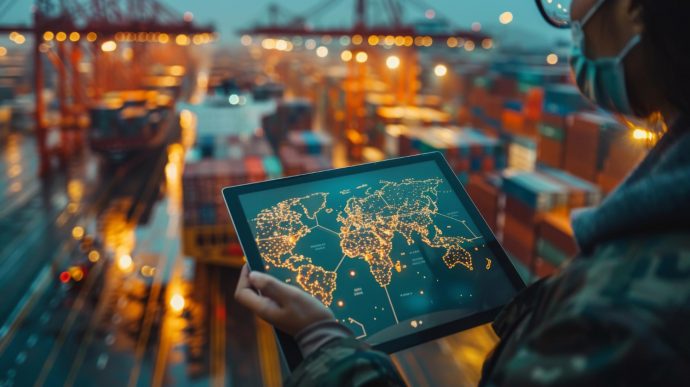The rise of the ‘smart port’ has led to major maritime hubs from Rotterdam and Hamburg to Singapore and Busan to deepen their digitalisation efforts.
Modern systems and processes, such as robotics, artificial intelligence and automation, are being implemented alongside advanced communication and monitoring systems to create an interconnected network to boost efficiency and better navigate fluctuating shipping trends and trade flows.
Real world
Real-world examples, particularly in the Middle East and Asia, demonstrate significant efforts to make ports smarter and more efficient. The 2023 Container Port Performance Index published by S&P Global and the World Bank cites Yangshan Port in China and Port of Salalah in Oman as the world’s leading two containerised ports due, in part, to the progress made in digitalisation.
Meanwhile, Singapore’s the Maritime Port Authority has introduced the digitalOCEANSTM initiative to develop and promote open and common data standards and application interfaces with ports and shipping-related platforms. It is designed to reduce repetitive manual form filling at ports along trade routes to boost port clearance efficiency.
Singapore’s Tuas Port is on its way to becoming the world's foremost smart port. By the time it is fully operational and capable of handling more than 65 million TEUs annually in 2040, it will be entirely digital and automated, enabling streamlined vessel clearance, just-in-time operations and improved turnaround time of ships in the port. Tuas is also set to use drones, self-driving electric vehicles and automated pavement functions to minimise human-to-human contact and embrace its position as the 'port of the future'.

Strategic transformation
As ports evolve, so too must ship agents. They serve as the primary information hub for crews and vessels, ship owners and port operators, and increasing digitalisation will generate more real time data which smart agents will use to provide smoother, more efficient port calls.
GAC has taken a strategic approach to implementing its digital transformation.
“As a ship agent, we cannot just say ‘let’s go digital’ because we are just one part of a big system that involves government regulations, port regulations, insurance companies, and so on,” says Martin Wallgren, GAC’s Chief Information Officer.
“There are so many parties involved in a ship or port call, we have to take the transition step by step. Digitalisation is just like any normal business change. We need to think about human and machine in tandem, considering change management and the psychology behind how to make people adapt. If you just provide a digital tool without considering the human element, there’s not much value.”

Lars Hardeland, GAC’s Group Commercial Director, Shipping, says greater access to data enhances ship agents’ understanding of the complexity of port calls.
"By embracing technology to improve informed communication on port regulations or weather conditions, GAC will be better placed to provide greater services and certainty to vessels and crews docking at ports at the more than 50 countries we serve worldwide,” he says.

Real-time
GAC’s new Port Line Up digital solution is a comprehensive online visualisation tool offering real-time updates on port activities, including vessel arrivals, departures and berth assignments. Standardised, up-to-date information improves voyage planning, reduces administrative workload and supports better decision-making.
“GAC teams around the world are the local experts, and their in-depth knowledge helps ensure vessels can dock successfully, crews can disembark and board smoothly, and cargo can be processed efficiently,” adds Lars. “Technology will help us on that mission, but only if we embrace it effectively.”
The Crew Desk Automation of the GACagent operational system automates the updating of crew members' passports and visas. By reducing manual work and errors, this feature speeds up processing and ensures that documentation is always current, making operations more efficient and reliable.
The human element
Amid the march of technology and automation, the need for the human element remains.
“Smart ports will become fully interconnected networks of information for all parties of a port call,” says Lars. “But that doesn’t diminish the role of our people on the ground to support the needs of a vessel and its crew. They are the ones with detailed knowledge of local requirements that can vary widely depending on location. Such expertise can help avoid unexpected issues or delays.
“For nearly 70 years, GAC has adapted to the changing needs of our customers and global trade. We will continue to do so in the new digital age.”